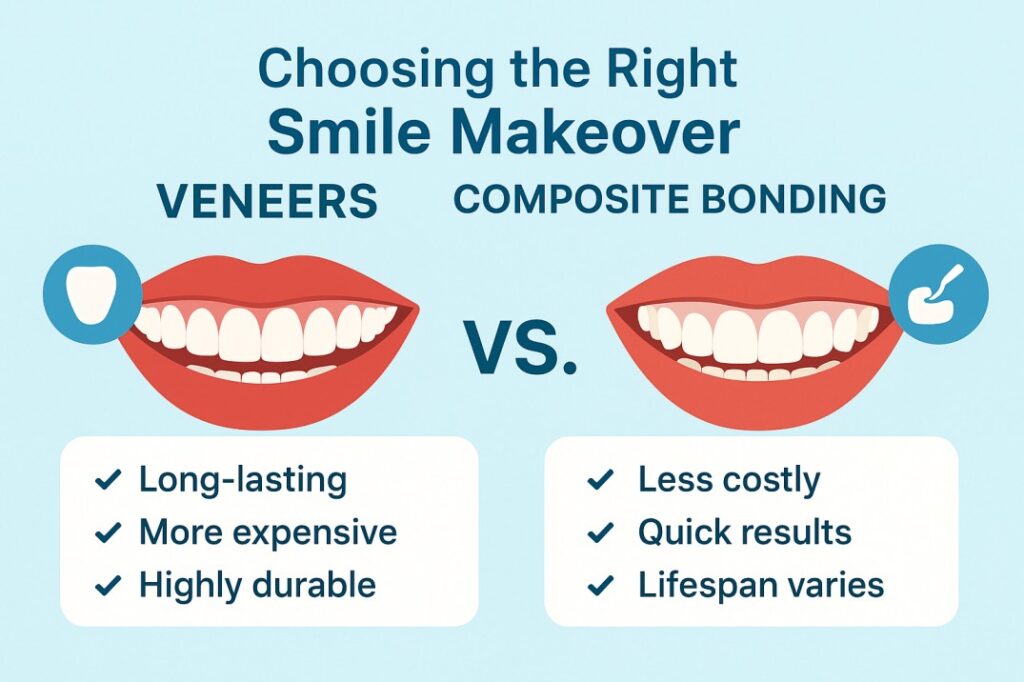Best Dental Clinic In Bangalore Indiranagar | Best Dentist in Bangalore Indiranagar
Home » Blog » Cosmetic Dentistry » Veneers vs. Composite Bonding: Choosing the Right Smile Makeover
Veneers vs. Composite Bonding: Choosing the Right Smile Makeover

A beautiful smile can boost confidence, enhance first impressions, and transform your overall appearance. Thanks to modern dentistry, cosmetic treatments like veneers and composite bonding make it possible to achieve your dream smile quickly and effectively. But which option is right for you? Let’s break it down.
What Are Veneers?
Veneers are thin shells, usually made of porcelain, custom-crafted to fit over the front surface of your teeth. They are known for their natural look, strength, and durability.
Benefits of Veneers:
- Long-lasting (10–15 years with proper care)
- Resistant to staining
- Natural, translucent appearance
- Ideal for significant cosmetic changes
Considerations:
- Irreversible (requires removal of a thin layer of enamel)
- Higher cost compared to bonding
- Requires at least two dental visits
What Is Composite Bonding?
Composite bonding involves applying a tooth-colored resin directly to the tooth surface and shaping it to improve appearance. It’s a quicker, more affordable solution.
Benefits of Composite Bonding:
- Cost-effective
- Usually completed in one visit
- Less enamel removal (preserves more natural tooth structure)
- Easily repairable
Considerations:
- Less durable (typically lasts 4–7 years)
- More prone to staining and chipping
- May not provide as dramatic a transformation as veneers
Veneers vs. Bonding: How to Decide
Feature | Veneers | Composite Bonding |
Longevity | 10–15 years+ | 4–7 years |
Cost | Higher | Lower |
Aesthetic Quality | Superior, natural translucency | Good but less lifelike |
Stain Resistance | Highly resistant | Prone to staining |
Reversibility | Irreversible | Reversible/repairable |
Procedure Time | 2+ visits | Usually 1 visit |
Which Smile Makeover Is Right for You?
- Choose Veneers if you’re looking for a long-lasting, dramatic transformation and are okay with a higher investment.
- Choose Composite Bonding if you want a quick, budget-friendly solution or minor cosmetic touch-ups.
Ultimately, the best choice depends on your goals, budget, and dental condition. A consultation with your dentist will help determine the right treatment for your unique smile.
Both veneers and composite bonding offer excellent ways to enhance your smile. Veneers provide durability and a flawless finish, while bonding offers affordability and convenience. Whichever you choose, both can help you achieve the confidence that comes with a beautiful smile.
FAQs on Veneers & Composite Bonding
- Do veneers look more natural than bonding?
Yes. Veneers mimic the translucency of natural teeth better, giving them a highly realistic look. - Is composite bonding painful?
No. The procedure is usually painless and rarely requires anesthesia unless there’s decay to address. - Can veneers be whitened later?
No. Veneers don’t respond to whitening treatments, so their shade is chosen beforehand. - How do I maintain composite bonding?
Brush and floss regularly, avoid biting hard objects, and limit staining foods/drinks to prolong results. - Which is better for chipped teeth?
Both work well, but bonding is a quicker fix for minor chips, while veneers are preferred for larger or multiple chips.
